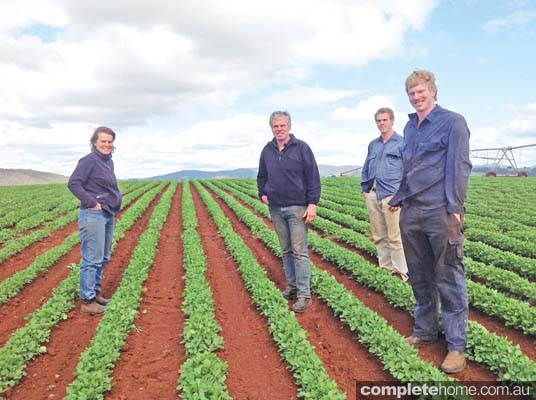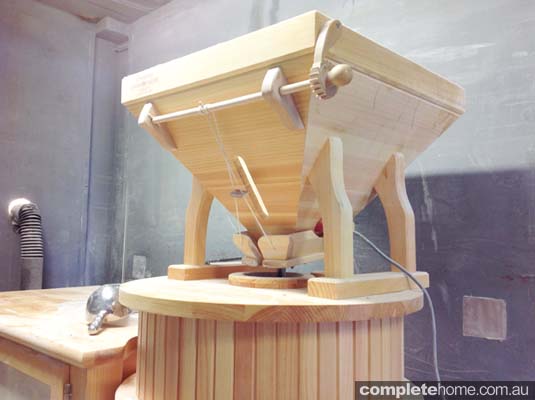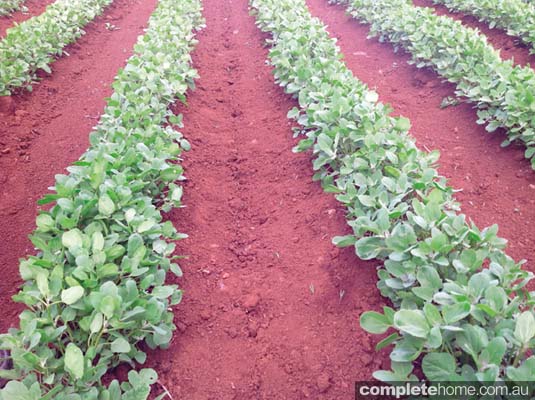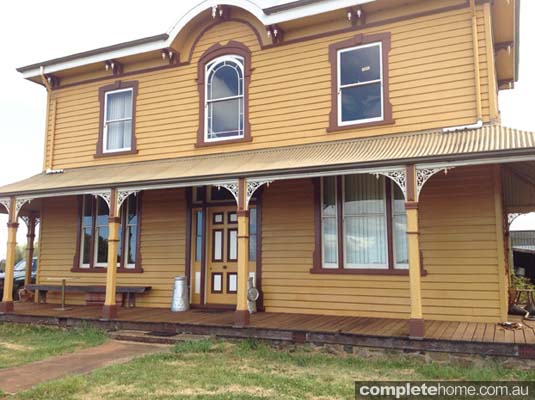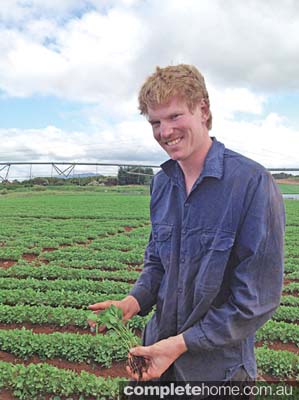A family-operated organic farm in an historic part of Tasmania has made quinoa part of its success story
It was a cold, blustery day when I visited the Damen family at their small organic farm in Tasmania’s northwest. Lauran Damen quickly ushered me into the large old country kitchen where it was warm, comfortable and pleasantly fragrant with home baking.
As I settled at the wooden kitchen table, Henriette appeared with offers of tea and home-baked quinoa and apricot muffins. Lauran and Henriette’s eldest son, Peter, who was working in the paddocks, joined us. The 23-year-old has completed an agriculture degree at the University of Tasmania in Hobart and now works full-time on the farm.
“He’s in charge of growing our crops,” Lauran explained.
Peter reported that his brother John, 21, an engineering student, was busy in one of the sheds tinkering with some equipment but said he’d join us later to walk around the property.
Historic links
Kindred Organics is a family concern and the quaint two-storey heritage home is the heart of the business. The old house dates back to 1885 and comes with an interesting history.
Like the Damens, the house was relocated to its current site. It once sat on an adjacent property four kilometres away but was moved to its new location some 25 years ago. Despite being uprooted, the timber house is in good condition.
“It’s not heritage listed,” said Lauran, “but we look after it and it looks after us.”
The house, sheds and silos where the Damens’ produce is processed and stored sit on top of one of the rolling hills of this picturesque and fertile part of northwest Tasmania. Not just a snappy name for a family business, Kindred is the name of this farming community about 20 minutes southwest of Devonport.
The Damens’ farm covers 237 hectares and enjoys cold, wet winters and mild, dry summers. The soil is productive and water abundant from a series of large lake-sized dams on the property.
The Damens came to Australia from Holland 14 years ago keen to find a better climate to live in and continue farming. Lauran explained that they looked at Canada as the place to start their new life but discounted that part of the world as too cold for farming for half the year.
“We looked for a place to farm and a good place to live that was well kept,” Lauran explained. “We didn’t want to restore a rundown farm — we wanted a going concern.”
When they discovered the northwest of Tasmania they realised it was a place where you could grow practically anything. They loved the mild climate and rich red soil. Their property is a patchwork of fields set against the dramatic backdrop of the Western Tiers and Mount Roland.
Back in Holland they grew potatoes and other vegetables, including kale, spinach, witlof, peas, onions, sugar beet and parsley. In Australia they put in crops of Brussels sprouts, carrots and pyrethrum but soon moved into a range of different crops, which they now grow organically.
Becoming organic
When they arrived in Tasmania, the Damens farmed in the conventional way, growing vegetables. As they began to understand more about their farm and the economics of the crops they were growing, they became more interested in organic methods.
Slowly they began to use organic methods, reducing chemical use, making compost and turning green weeds back into the soil as green manure.
“We had to become organic step by step as we still had to pay the bills,” Lauran explained, adding that they had to find new markets as none of their previous customers — packers or processors — was at that time interested in organics.
Once they achieved organic certification they realised they had to concentrate on non-traditional crops to provide a higher return for their labour. “There wasn’t a viable market here for organic broccoli,” recalled Lauran. “Back when we became organic growers, no one wanted to pay more for an organically grown product.
“We saw a niche for healthy crops to sell through health food and specialist shops and began to trial hardy, pest-proof crops that were better suited to organic growing.”
After lots of trial and error, Kindred Organics now produces organic adzuki beans, buckwheat, oats, spelt, linseed and quinoa (see page 12 for more on how to grow this fascinating crop), which are distributed to Brisbane, Sydney, Melbourne and Adelaide and also available throughout Tasmania.
They also produce organic meat along with feed grain, straw, hay, grass seed, clover seed and lupins.
Discovering new crops
Lauran and Henriette are pleased with what they’ve achieved by following organic methods and growing new and challenging crops: “We enjoy the challenge of working with nature rather than fighting with nature.”
They are particularly proud of their quinoa (pronounced keen-wah), which they’ve been perfecting over the past six years. As well as working out how to grow this ancient Andean crop, they’ve also developed the equipment to process it.
“Until we started to grow the crop, most of the quinoa available in Australia came from North America and places like Peru and Bolivia,” said Henriette. “That’s a lot of food miles.”
Originally, a friend gave them some quinoa seeds to try. They sowed them and were impressed with how it performed. Henriette in particular was excited by the health benefits of this seed crop.
“It’s gluten free and a complete protein,” she said. “It’s good for you because everything in it can be used by the body — it’s better than milk.” She is now producing prewashed quinoa seed and also grinding the seed on the farm to produce organic quinoa flour.
Henriette is also responsible for grinding the spelt flour produced on the farm. The family turned to spelt after finding that wheat and many other traditional cereal crops were difficult to grow organically as they needed constant input from the likes of organic fungicides to keep healthy.
Spelt, an ancient grain crop, is much tougher than modern wheat. It has a tall upright growth that puts it above the weeds, Lauran explains proudly. It also has a covered seed, which protects it from pests.
Challenges
According to Lauran and Henriette, weeds are the toughest challenge to deal with on an organic farm. “We manage weeds with a combination of mechanical methods, hand weeding and growing cover crops such as clover,” Lauran explained. “Weed control is very labour-intensive but hand-weeding is part of being organic.”
As they’ve worked the soil, they’ve realised not all weeds are bad. “We have a lot of vetch here; it’s a legume, so we often use it along with clover to put nourishment back in the soil,” added Lauran.
“We keep on improving the machinery we use to manage the weeds so we favour our crops and make growing as efficient as possible.”
Living in history
The heritage house that’s the heart and soul of Kindred Organics and home to the Damen family has links to Tasmania’s wilderness heritage.
It was the original home of the Cowle family. Thomas and Emma Cowle built the house and farmed at Kindred in the late 19th and early 20th centuries. One of their nine children, Kate, married Austrian émigré Gustav Weindorfer and the pair helped to open up nearby Cradle Mountain to walkers.
Gustav and Kate were amateur botanists and walkers, enthusiastic about the beauty of the Cradle Mountain area and its unique vegetation. They realised that a hut was needed to encourage visitors to visit and stay in the area as it was so remote.
In 1912 they bought land near the mountain, where they built a chalet they called Waldheim. Before roads were made through the area it was a 13km walk to reach Waldheim, but nevertheless walkers came to this newly accessible part of Tasmania.
As well as opening up the area to early tourism, Gustav Weindorfer was also instrumental in having the area from Cradle Mountain to Lake St Clair declared a national park.
Advice from the farm
• Lauran and Henriette Damen have top advice for gardeners based on their experience of growing organically.
• Grow clover between crops to suppress weeds and add nitrogen to the soil. After harvest, the clover covers the soil through winter.
• Smothering oxalis-infested soil with plastic or a tarp is the only way to get it out of the garden. It may take a year but blocking the sunlight stops it growing. As the tubers have to grow each year, with no sunlight for more than a year, the cycle of growth is broken.
• Concentrate on what grows well in your local area. We don’t grow bananas here — it’s too cold — but quinoa thrives.
• Green weeds aren’t waste — put their nourishment back into the soil by composting.
• Make sure your basics are good. Whether you’ve one square metre, 100 square metres or 10,000 square metres, there’s no difference. Make sure your ground has good drainage, not too much shade and reliable nutrition, including lime. Protect the crop from pests and wildlife and make sure you do what has to be done on time.
Words & Photography by Jennifer Stackhouse
Originally from Good Organic Gardening magazine, Volume 5 Issue 6

